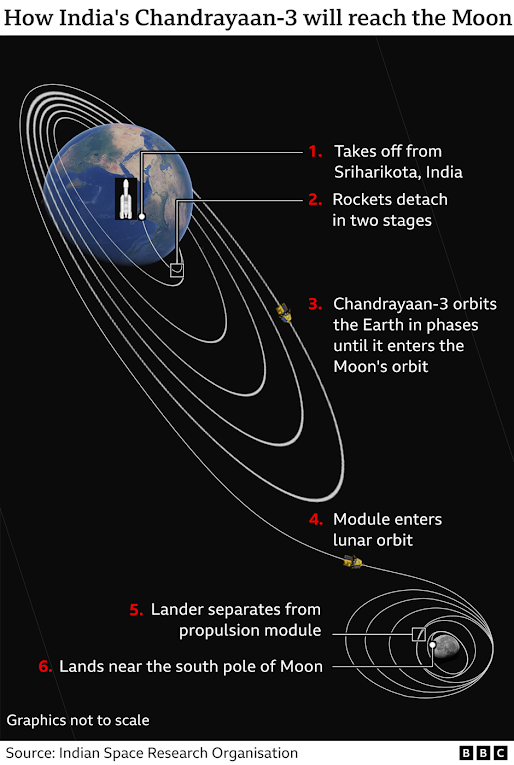Chandrayaan-3: India's Lunar Triumph
CHANDRAYAN 3
The Indian space research organization’s third lunar mission in the last 15 year. The spacecraft with an orbiter, lander and a rover lifted off on 14 July 2023, 14:35 IST
Propulsion module
The propulsion module carries the lander and rover configuration to a 100 km lunar orbit. It is a box-like structure with a large solar panel mounted on one side.
Lander
Vikram (after the founder of ISRO)is a box shaped structure that carries various instruments for scientific analysis. It has 4 legs (unlike chandrayaan-2 which had 5 thrusters) which are responsible for a smooth landing and each of them can generate 800 Newtons of thrust.
It is equipped with a Laser Doppler Velocimeter (LDV) to allow measuring attitude in 3 directions. The impact legs have been made stronger compared to Chandrayaan-2 and instrumentation redundancy has been improved. It will target a more precise 4 km x 4 km landing region based on images previously provided by OHRC on Chandrayaan-2. ISRO improved the structural rigidity, increased polling in instruments, increased data frequency and transmission, and added additional multiple contingency systems to improve lander survivability in the event of failures during descent and landing.
Rover
The Pragyan (Sanskrit word for wisdom) rover is a six-wheeled vehicle with a mass of 26 kgs .The rover is expected to take multiple measurements to support research into the composition of the lunar surface, the presence of water ice in the lunar soil, the history of lunar impacts, and the evolution of the Moon’s atmosphere.
Earth-bound perigee firing
The "Earth-bound perigee firing" is a critical maneuver that takes advantage of the spacecraft's closest approach to Earth to adjust its trajectory and velocity, enabling it to successfully enter lunar orbit. This complex series of maneuvers requires precise calculations and execution to ensure safe and accurate journey of Chandrayaan-3 to the Moon.
1. Initial Launch: The spacecraft is launched from Earth and enters a preliminary orbit around our planet.
2. Trans-Lunar Injection (TLI): After spending some time in Earth's orbit, the spacecraft needs to accelerate and adjust its trajectory to escape Earth's gravitational pull and head toward the Moon. This maneuver is called the Trans-Lunar Injection (TLI) burn. It propels the spacecraft onto a trajectory that will intersect with the Moon's orbit.
3. Earth-Bound Perigee: As the spacecraft follows its trajectory after the TLI burn, it will reach the point in its orbit where it is closest to Earth. This point is known as the perigee.
4. Perigee Firing: At the perigee, the spacecraft performs a firing of its engines. This maneuver is called the "Earth-bound perigee firing." The purpose of this firing is to further adjust the spacecraft's trajectory and increase its velocity. By doing so at the perigee, the spacecraft gains the maximum benefit from Earth's gravitational assistance, which helps it achieve the necessary velocity to enter lunar orbit.
5. Lunar Orbit Insertion (LOI): The combination of the TLI burn, subsequent trajectory adjustments, and the perigee firing allows the spacecraft to reach the Moon's vicinity. Once the spacecraft is close enough to the Moon, it performs another burn known as the Lunar Orbit Insertion (LOI) burn. This burn reduces its speed and allows the spacecraft to be captured by the Moon's gravity, entering into lunar orbit.
South pole of the moon
The south pole of the moon is not yet fully explored. It is tough to get a soft landing on the south pole. The terrain of the south pole is tougher and bumpier, littered with crates and deep trenches, devoid of proper sunlight. Chandrayan 2 and Russia’s Luna -25, both crash-landed on the south pole. During landing the robotic movement must be perfectly coordinated, any error in the hardware or software could cause a crash. While landing if there is a boulder that comes in the way or moon dust which messes with the sensors then the mission fails.
Water on moon
On the south pole of moon, the sunrays hit the moon at a very strange angle, casting long shadows. In these regions, temperatures plummet to astonishing lows of -248 C, because the Moon has no atmosphere to warm up the surface. There are cold polar trenches which have been untouched by sunrays and hence may contain frozen ice and water which has accumulated there over millions of years. This would provide a unique sample for scientists to analyse and understand the history of water in our solar system. The possibility of water opens new doors to explore human missions to moon where water would be a requirement for survival. Previously, Chandrayan 1 and Chandrayan 2 have detected hydroxyl and water traces on the moon.
Overcoming several challenges, on 23rd August 06:03 PM IST, everyone rejoiced as Chandrayan 3 had a ‘Safe and Soft’ landing!
After India, NASA’s Artemis mission is set for a lunar touchdown in 2024, while China aims to land on the coveted south pole by 2026 — all possibly taking us closer to unravelling all the mysteries of Earth’s constant companion.
Credits: Ishita Humnabadkar- Thursday Awareness COEP BLOGS.


Comments
Post a Comment